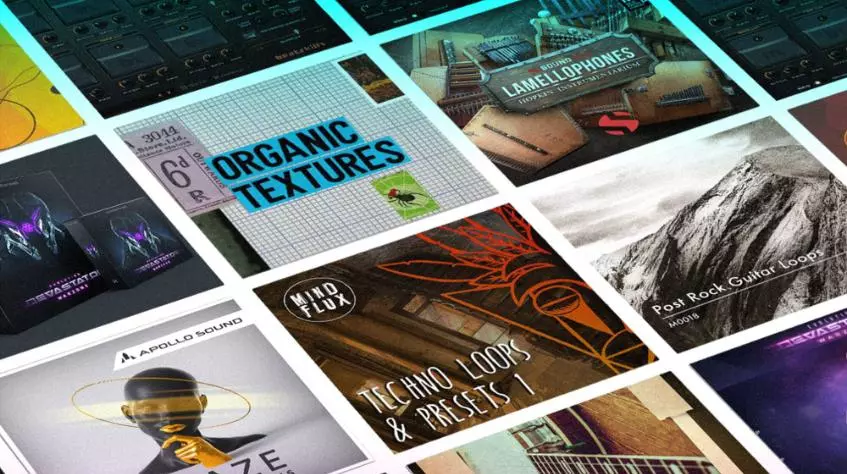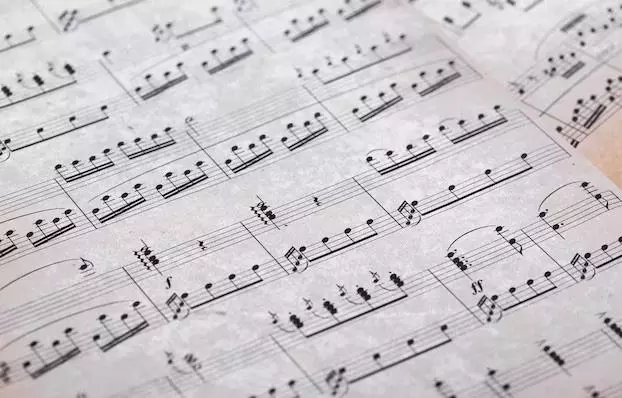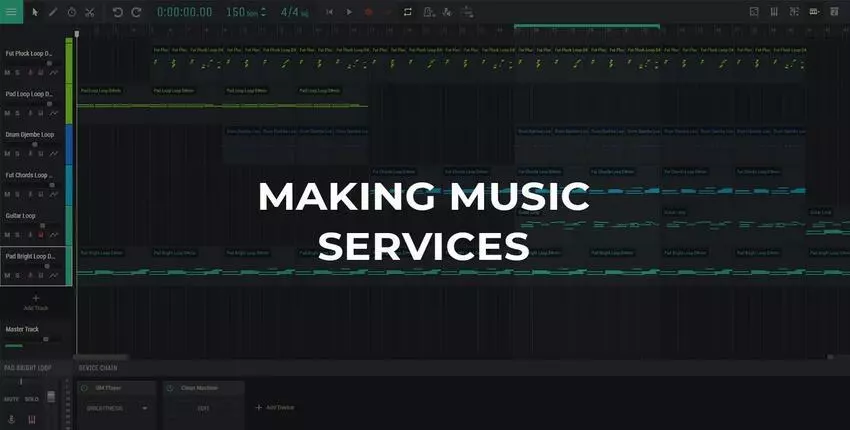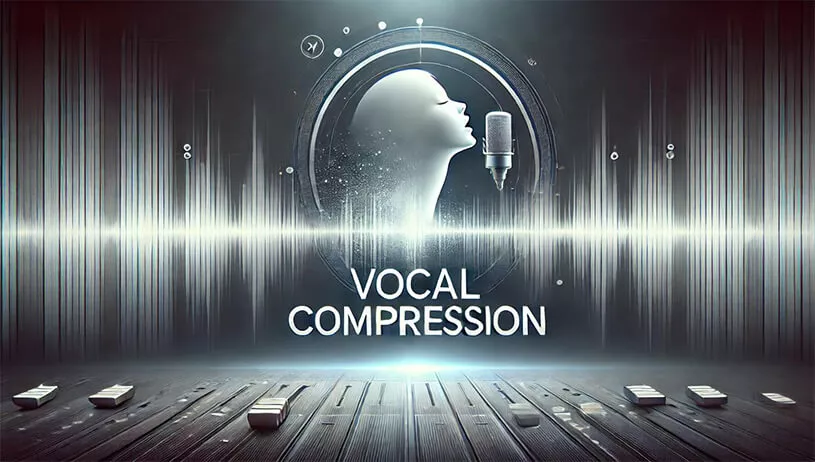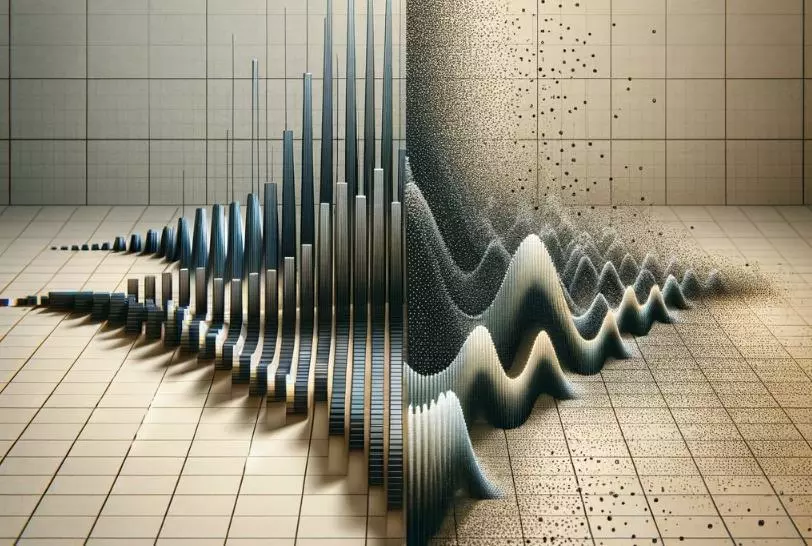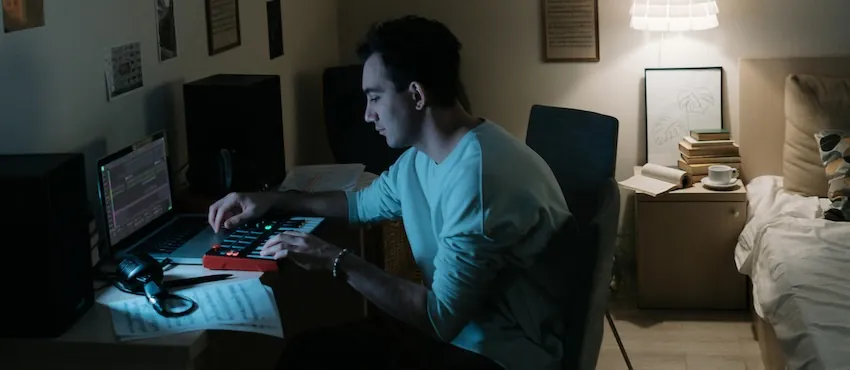Best saturation plugins VST
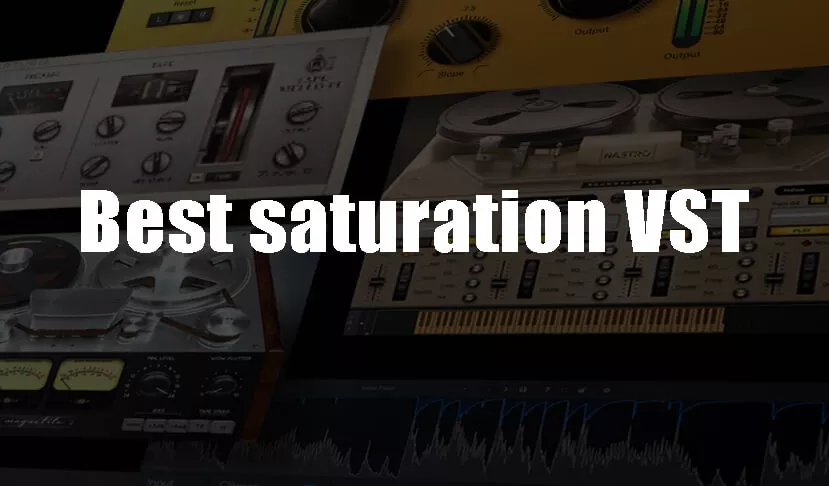
Saturation is the effect of saturating a signal with even and odd harmonics, which occurs due to the “rounding” of the peaks of the phonogram.
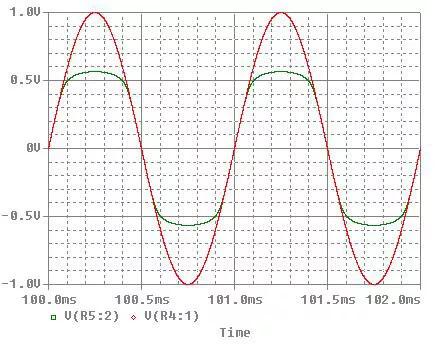
Saturation is a type of effect that is achieved using tube gear or VST plugins (such as exciters and saturators). The more saturation you add, the more distorted and dull the sound becomes.
Saturation can significantly change the overall sound of your mix, adding brightness and richness to individual tracks and the entire project. With so many options available, it’s important to find the saturation plugins that best suit your needs and style.
In this comprehensive guide, we’ll introduce you to the 15 best saturation plugins, categorized for your convenience. We’ll cover everything from free options to versatile and creative plugins.
Plus, we’ll share additional tips on using each plugin to help you improve your music production skills. We’ll also cover key techniques for using saturation plugins effectively, such as parallel processing, subtle saturation, adjusting the input gain, and soft limiting. By the end of this guide, you will have a clear understanding of saturation and be equipped with the best tools to improve your music production.
What is Saturation?
Saturation is an important aspect of digital music production, often used to create the pleasing warmth, depth, and harmonic overtones characteristic of analog equipment. This effect is due to the non-linear behavior of audio circuits that add distortion and harmonics to an audio signal as it reaches and exceeds its maximum dynamic range.
In digital audio, saturation plugins reproduce the desirable properties of analog devices such as:
- Tape recorders;
- Tube amplifiers;
- Solid state devices.
They achieve this by using complex algorithms that simulate the behavior of analog equipment. These plugins can add both subtle and more pronounced warmth and character to your mixes, creating an analog ambience while retaining the benefits of digital audio processing.
Saturation Benefits
Digital music production faces unique challenges, such as sterile or overly clean sound, and a lack of depth and character. Saturation plugins can help overcome these challenges by adding harmonic complexity and giving your mixes a more natural, warm feel. Their benefits include:
- Increased warmth and depth. Saturation plugins make individual tracks or the entire mix sound richer and warmer, giving your productions a more cohesive, full-bodied sound;
- Increased presence. By adding harmonics and subtle distortion, saturation helps tracks stand out in a mix, making them more interesting and dynamic;
- Gluing the mix together. Saturation plugins help bring elements of a mix together, creating a more cohesive, unified sound;
- Controlled dynamics. Using saturation helps control the dynamic range of your tracks, giving them a more consistent, controlled sound quality.
Overall, saturation is a powerful tool in digital music production that can help you achieve a more natural, warm, and expressive sound, bringing your mixes to life.
Different Types of Saturation
Tube Saturation
Tube saturation is created using vacuum tubes, which are used in analog devices such as guitar amps and preamps. It generates both odd and even harmonics, adding warmth and character to the audio signal. This type of saturation is especially useful for adding warmth to sterile digital recordings or enhancing specific elements of a mix, such as vocals or guitars. Use tube saturation to give a clean guitar track a more vintage and crunchy tone, adding edge and warmth.
Tape Saturation
Tape saturation occurs when recording to magnetic tape, which was common practice before the advent of digital recording. This type of saturation is characterized by soft compression, slight distortion, and a smooth roll-off of the high frequencies. It can add warmth and “glue” a mix together, making it feel more cohesive and unified. Apply tape saturation to a drum bus to add coherence, warmth, and subtle compression, resulting in a more natural, lively sounding drum kit.
Transistor Saturation
Transistor saturation is a different type of saturation than transformer saturation. While transformer saturation is related to the nonlinear behavior of magnetic cores, transistor saturation refers to the nonlinear behavior of transistors, which are semiconductor devices commonly used in audio circuits. Transistors are known for their unique saturation character, causing distortion that is different from tube or transformer saturation. They are often found in analog equipment such as guitar pedals, preamps, and compressors, adding color and texture to the sound.
Analog and digital saturation
Analog saturation is an original form of saturation achieved by passing audio signals through analog devices such as tube amplifiers, tape recorders and transformers. Digital saturation plugins strive to replicate the characteristics of analog saturation, providing the warmth, color and harmonic complexity that analog equipment brings to the sound.
While analog saturation can be more unpredictable and difficult to control, digital saturation plugins offer a more stable and controllable alternative. They’re also a more affordable and cost-effective option, making them an essential tool to have in your digital audio workstation (DAW).
Use a variety of digital saturation plugins to add depth, warmth, and harmonic complexity to a sterile digital mix, making it sound more organic and analog-like.
Saturation = Harmonics
Without going into complicated scientific details, let’s say this: harmonics are frequencies that are derivatives of the fundamental frequency (essentially, its copies with a higher frequency). These harmonics enrich and “heat” the original sound. However, such enrichment is not always pleasant to the ear. Harmonics that are multiples of the fundamental frequency in ratios of 2, 4, 6, 8, and so on are called even. Harmonics that are multiples of 3, 5, 7, 9, and so on are called odd. Some nonlinear systems generate more even harmonics, others more odd ones. The balance between even and odd harmonics has a significant impact on sound quality.

The top signal is the sound from a tube preamp at medium overdrive. Medium signal – from a tube preamp at a high degree of overload. The lower signal is from a transistor amplifier at a low degree of overload.
In my opinion, true saturation is only possible using analog devices such as tube amplifiers or reel-to-reel tape recorders, which cost a lot of money. VST plugins can only partially add a little color to the sound. Analog saturation adds subtle distortion to the original signal. Many sound engineers achieve analog sound in digital tracks by recording them on a high-quality tape recorder, and then returning the signal back to digital format. This method is especially popular when mastering rock music.
- From my experience, real lamp devices start at a price of about 50-60 thousand rubles. Anything sold as a “tube” preamp, such as the Behringer MIC500, ART Tube MP, DBX 286S, ART TPS II, is actually an imitation. In these devices, sound passes through a semiconductor, and a lamp is used only to create a certain visual effect.
1. Softube
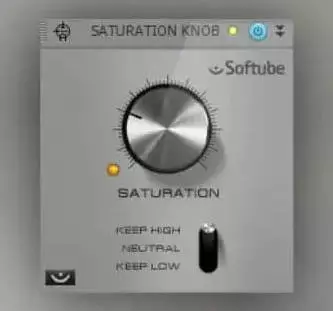
Let’s start with one of our favorite saturation plugins, Saturation Knob.
Softube released the Saturation Knob a few years ago, and its simple, one-button design quickly gained popularity. This plugin is designed for those who value fast workflow and high quality saturation.
Saturation Knob offers three saturation algorithms: neutral, low and high, depending on which frequencies you want to affect. You can easily adjust the saturation level using the large knob.
The beauty of the Saturation Knob is that it can be used on multiple channels in your mix because it doesn’t require much processing power. Whether you’re looking to add some saturation to a mix bus or add grain to multiple tracks in a session, the Saturation Knob is your go-to tool!
2. Tape Cassette 2
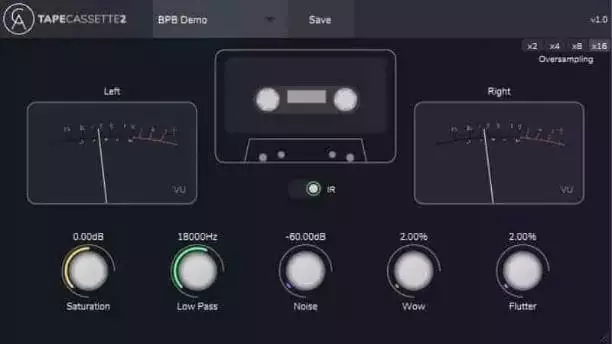
Tape Cassette 2 is an updated version of the original Tape Cassette plugin that retains all the noise, warmth and character of its predecessor. The main difference is that Tape Cassette 2 has a sleeker interface and improved internal architecture.
In addition to the original features, Tape Cassette 2 includes a new impulse response, improved saturation algorithm, real sampled tape noise, and an improved wah and flutter engine.
This plugin is best used on individual tracks to add vibration, warmth, texture and movement. It’s also great for experimenting with sound design beyond its basic capabilities.
Overall, Caelum Audio’s Tape Cassette 2 is a surprisingly dynamic and versatile saturation plugin that is a must-have in every producer’s arsenal.
3. Voxengo

When we’re looking for new free plugins, one of the first developers we turn to is Voxengo. Their Tube Amp plugin is incredibly good, giving the sound the drive, warmth and character of a real tube amp.
While the interface may not look exactly modern, the sound quality you can get with it is impressive. In the interface, the first three knobs control drive, offset, and low-pass filter. With their help, you can adjust the desired degree of saturation by switching between two types of tube distortion. The more saturation, the more complex and compressed the signal becomes.
At the end of the Tube Amp signal chain is an output gain knob with a convenient meter showing amplitude in dB.
If you’re looking to add grain and complex tube richness to your mixes, Voxengo’s Tube Amp is a great choice!
4. TUBA Analog Obsession
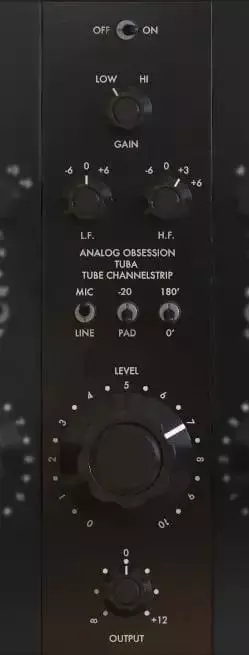
Another great tube saturation plugin is TUBA from Analog Obsession. This plugin can be inserted anywhere in your signal chain to create complex harmonic overtones. To increase harmonic complexity while reducing the source signal level, use the High and Low Gain settings.
Although the TUBA is fairly simple to use, it provides access to the high and low frequency shelves, as well as a switch between the mic and line inputs, depending on the type of input signal.
The feature that makes this plugin unique is the phase inverter. It does not process the entire signal, but inverts the phase of the processed part, which gives the sound a special richness.
No matter how much you tune the plugin, you can take advantage of the gain compensation function on the rotary knob, which automatically reduces the gain as the input signal increases, maintaining a constant level.
If you’re looking for high-quality, rich analog console-style sound, Analog Obsession’s TUBA is a great choice.
5. CODA Labs Szechuan Saturator
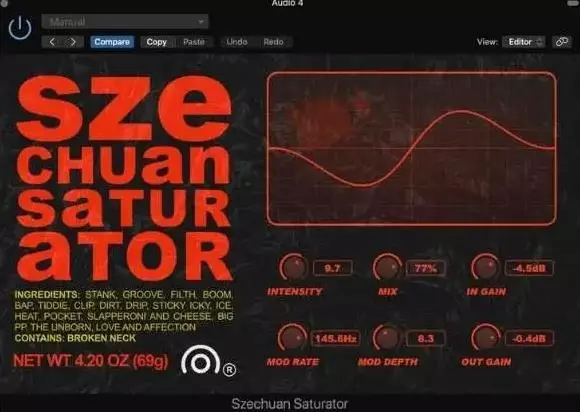
Another great tube saturation plugin is TUBA from Analog Obsession. This plugin can be inserted anywhere in your signal chain to create complex harmonic overtones. To increase harmonic complexity while reducing the source signal level, use the High and Low Gain settings.
Although the TUBA is fairly simple to use, it provides access to the high and low frequency shelves, as well as a switch between the mic and line inputs, depending on the type of input signal.
The feature that makes this plugin unique is the phase inverter. It does not process the entire signal, but inverts the phase of the processed part, which gives the sound a special richness.
No matter how much you tune the plugin, you can take advantage of the gain compensation function on the rotary knob, which automatically reduces the gain as the input signal increases, maintaining a constant level.
If you’re looking for high-quality, rich analog console-style sound, Analog Obsession’s TUBA is a great choice.
6. Bedroom Producers Blog BPB Saturator

BPB Saturator from Bedroom Producers Blog is one of the best free VST plugins for subtle saturation. The BPB Saturator interface offers six controls, including Treble, Bass, Tube, Tape, and Input and Output level controls.
What we particularly like is the ability to choose between tape and tube saturation, whereas these usually require separate plugins. You can also use a low-pass filter to reduce the high frequencies in your signal, giving it a richer, analog sound.
BPB Saturator is great for virtual instruments, adding warmth and harmonic distortion that helps them integrate better into the mix. The plugin has simple controls and a minimalist design that ensures low CPU usage and works well on almost any computer.
7. Shattered Glass Audio – SGA1566

The SGA1566 from Shattered Glass Audio emulates a vintage hardware preamp using dual 12AX7 amplifiers. This plugin offers a lot of impressive features, especially considering that it is free.
First, Shattered Glass Audio has included a switch to adjust the processor’s bass and treble frequencies, which can be toggled depending on the power of your computer. You also get two equalizer knobs that let you boost the high and low frequencies of the signal. The EQ can be used before or after applying saturation, making the plugin very versatile.
For an even more realistic tube sound, you can use the oversampling switch. Although this feature requires more processing power, it delivers great tube sound that’s great for all types of instruments, from drums and vocals to bass and more.
8. Nick Crow Lab TubeDriver

Nick Crow Lab’s TubeDriver plugin offers tube saturation that perfectly emulates the characteristics of real tube preamps. Once you add this VST plugin to your track, you will notice the complex harmonics generated.
At the center of the plugin are a drive section and a bias knob, which can be used together to boost harmonics and adjust the amplitude between the new complex harmonic signal and the original sound. On the right are the high and low pass filters, which have smooth and natural cutoff characteristics.
For ease of monitoring, the plugin includes buttons for phase inversion and monophonic listening.
Finally, the built-in EQ lets you fine-tune exactly what part of the signal you want to affect, which is especially useful when using this VST plugin in parallel.
9. Chowdhury – Chow Tape
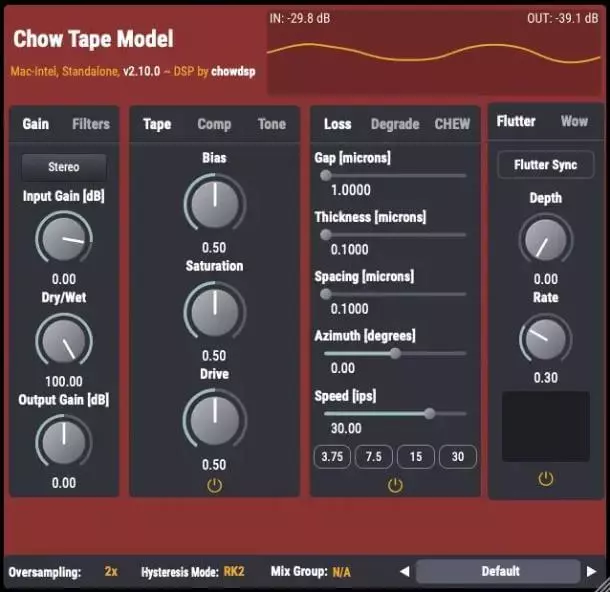
Released in 2019, the Chow Tape plugin is open source software that can be modified indefinitely. Although it was originally designed to emulate the tape saturation found on the Sony TC-260, the plugin quickly expanded its capabilities and is now capable of simulating a wide range of reel-to-reel tape recorders.
On the front side of the Chow Tape plugin you will find a variety of sliders and knobs for customization. The main focus is on the saturation control, which determines the saturation level of this VST plugin.
As you’d expect from a plugin that emulates analog tapes, it also includes a Bias control that affects signal quality, and wow and flutter settings that are great for adding a lo-fi flavor to your tracks.
In addition, Chow Tape provides access to several unique controls, including chew, tone, filter, decay, and tape compression. This plugin definitely has the potential to be one of the best tape saturation plugins on the market, and over time, as more people start working with its open source code, we will be able to appreciate its capabilities.
10. Analog Obsession PreBox

Although we’ve already discussed another plugin from Analog Obsession on this list, PreBox is so unique that it deserves its own attention. This plugin perfectly emulates an analog preamp, providing 11 different settings to create complex harmonic overtones depending on your needs.
Like a standard preamp, the input knob increases the amplitude of the input signal, increasing harmonic distortion and adding compression. Once you’ve set your ideal distortion level, you can switch styles to find the one that best suits your music.
Additional treble and bass controls allow you to fine-tune the effect on specific frequencies. Although easy to use, this plugin offers a variety of unique saturation styles suitable for almost any genre or instrument.
11. Sleepycat Audio – Crush

The Sleepycat Audio Crush saturation plugin may seem complex at first, but once you get the hang of it, you’ll find that it’s capable of creating unique distortions. This VST plugin is different from others on our list in that it emulates the crossover distortion of a Class B amplifier between the input and output. Thus, immediately after installing this free saturation plugin, you will get a very unusual effect.
To boost the signal before distortion, you can use the Pre Gain function. You can also reduce the bias level to create more distortion.
Additionally, the plugin has an Alias feature that disables oversampling, suppressing phase at high frequencies and adding a bit of intermodulation distortion.
The Edge feature remains a bit of a mystery. Even the manual doesn’t fully explain how it works, but when you use it you will notice that the distortion from the Bias slider is reduced.
Of course, you can use the high and low pass filters to further clean up your mix, or mix the plugin in parallel using the Wet/Dry slider. There is no similar free VST saturation plugin on the market.
12. IVGI

IVGI is one of the classic free VST saturation plugins that remains relevant to this day. This unique plugin makes it easy to add warmth and character to your mix in seconds.
The Drive control allows you to introduce complex harmonic overtones while reducing the output to maintain a constant level. There is also an Asym Mix control, which determines the degree of signal compression. Set it to 0 and you’ll get no compression, but set it to 10 and the signal will be as compressed as possible, giving it that crunch you know and love.
Overall, this VST plugin is very easy to use and is ideal for those just getting into the world of saturation and looking to quickly eliminate the sterility of their sound.
13. Roxolder – Tomato Preamp
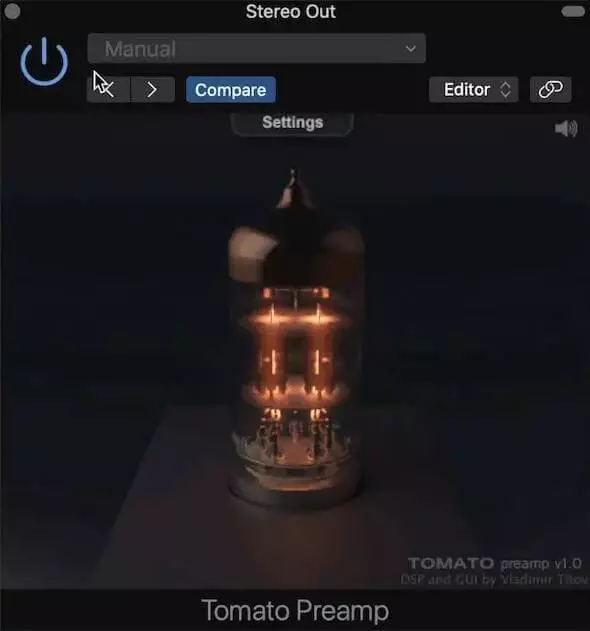
One look at the Tomato Preamp plugin might make you think of “warmth,” but it actually creates a unique lo-fi sound that’s perfect for adding character to signals that sound too clean. If you want to give your tracks an unexpected twist, this is one of the best free VST saturation plugins.
The plugin offers three different lamp models for experimentation. The “New” model provides a warmer, slightly richer sound while maintaining signal purity, while the “Aged” model offers the harshest, most distorted sound.
Each setting sounds like it’s accompanied by a high-pass filter, which attenuates the low frequencies for a more subtle signal. Despite the chaotic nature of the lamps, Roxolder offers such precise algorithms that you can be confident in the results when using different settings.
Unfortunately, this plugin does not have the ability to adjust the input, output, or gain level, which limits its functionality somewhat. However, due to its unique features, we have included it in our list of free saturation plugins.
14. Leveling Tool

If you’re looking to add simple warmth and analog saturation to your audio, the Leveling Tool is a fantastic plugin. Its interface is incredibly simple, and its 4x oversampling provides amazing results.
While the controls indicate that the Leveling Tool is primarily a compressor, with drive and input gain functions that let you control the amount of saturation, it can also add extra drive.
This plugin is great for vocals, drums, bass, and any other tracks that need a little taming.
15. Audio Assault – Headcrusher Free

Headcrusher Free is an analog saturation plugin that’s great for processing drums, vocals, bass, and more. Although we experimented with it on various tracks, we especially liked its use on the master bus. The plugin provides unique richness and adds distinctive clicks using just a few controls.
This plugin doesn’t have any complex features, but if you’re looking to give your master bus a vintage, rich sound, it’s one of the simplest and most effective tools for the job.
16. Aux Saturation
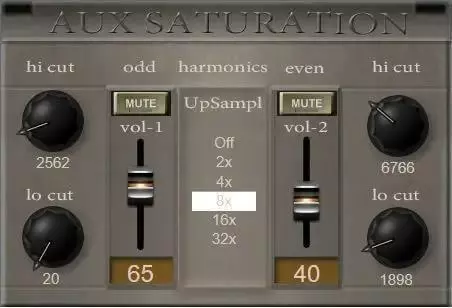
Sometimes you don’t need a specific saturation style, but just want to enhance the harmonics in your sound using standard harmonic processing. In this case, Aux Saturation is one of the best plugins for this task, since it does not emulate either tape recorders or vintage tube amps.
Instead, it uses a unique algorithm to give the sound richness and liveliness. The plugin has two sliders that allow you to mix even and odd harmonics, as well as high and low pass filters on the output stage.
Although Aux Saturation does not have complex features, its interface is very easy to use and the end result is of high quality.
17. Wave Arts – Tube Saturator Vintage
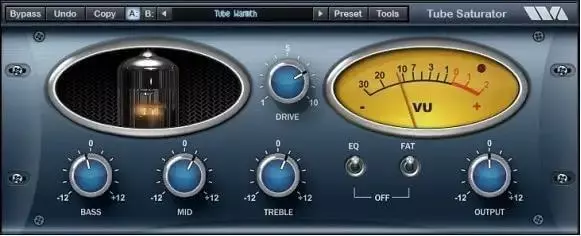
When the original Tube Saturator plug-in came out, it became one of the best tools for those who wanted to get the true sound of vintage tubes. With the release of the second version of Tube Saturator, users now have even more powerful and realistic circuit modeling technology, allowing the plugin to sound like a real tube amp.
The plugin is based on emulation of a three-band Baxandall equalizer, powered by dual 12AX7 triode preamps – the same ones used in hi-fi amplifiers. This produces sounds and characteristics similar to those experienced when passing a signal through a high-end tube amplifier.
It’s worth noting that due to the high CPU load of this circuit simulation technology, you may not be able to use it in large projects unless your computer is powerful enough.
18. SPL TwinTube
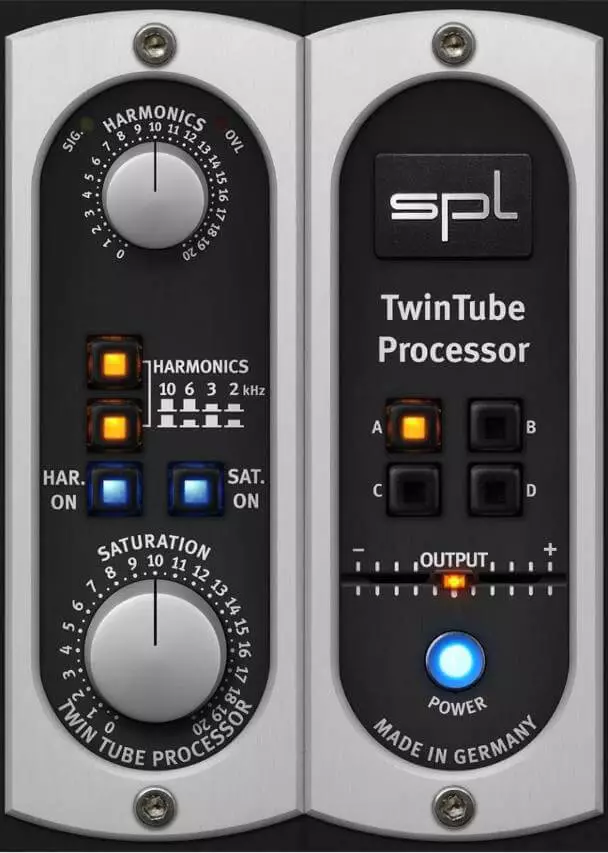
The TwinTube module is a unique combination of two important tube effects in one processor: saturation and harmonic processing. Both stages operate separately from each other and are based on independent processing steps. These effects can be used individually or together.
In the original analog design, saturation is created by pushing the tube beyond its normal operating capabilities. Unlike semiconductors, a tube brought to this level does not immediately clip, but gradually approaches its extreme values, creating a characteristic tonal effect. This allows you to obtain clean acoustic results when processing the audio signal.
19. Wave Arts Tube Saturator 2

Tube Saturator algorithms are based on real-time analog circuit simulation technology. Wave Arts carefully simulated the voltages and currents passing through every tube, resistor and capacitor in the two-stage triode preamp with three-band analog EQ, aiming to capture every detail of the real thing. This powerful tube amp simulator infuses your sound with analog warmth and incredible density.
This plugin is currently one of the best tube amp simulators out there. It has a compact size and exquisite interface. The main difference between this plugin and other similar devices is the use of modern technology for simulating analog circuits, which allows it to sound the same as a real analog device.
20. Decapitator
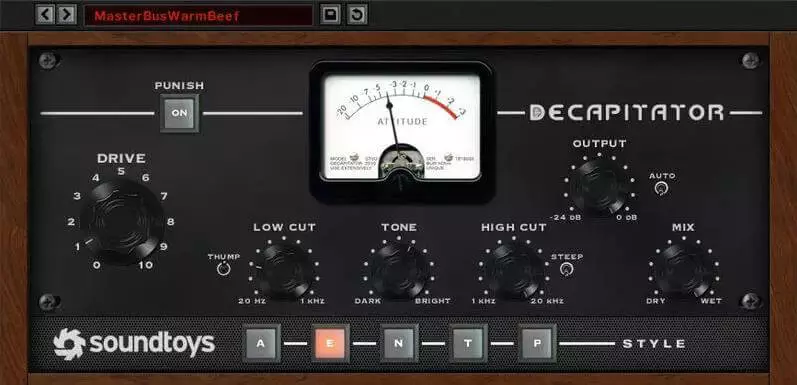
The Decapitator is very close to analogue sound and responds very well to the dynamics of the sound passing through it. Decapitator’s processing styles are precisely modeled to give your sound tone and vibrancy. The added mix control allows the plugin to be used in parallel audio processing, which makes it even more convenient.
The plugin integrates a wide range of analog saturation effects that match the physical hardware used to create it. However, saturation does not always have to be subtle and soft. That’s why Decapitator has added a “Punish” button, which turns the saturation plugin into a powerful and aggressive distortion.
21. Solid State Logic – SSL Fusion Vintage Drive

Fusion Vintage Drive is a plug-in for your DAW that emulates the non-linear saturation circuit of the Vintage Drive processor from SSL’s award-winning Fusion Stereo Analogue Colouration hardware. Simply put, this plugin recreates the saturation of SSL’s FUSION analog device.
It is designed to create subtle harmonic saturation and gentle compression reminiscent of vintage gear in the analog sweet spot, delivering authentic analog distortion. Fusion Vintage Drive is an essential tool for adding an organic analog feel to your tracks, bands, mixes and mastering.
22. FabFilter Saturn 2
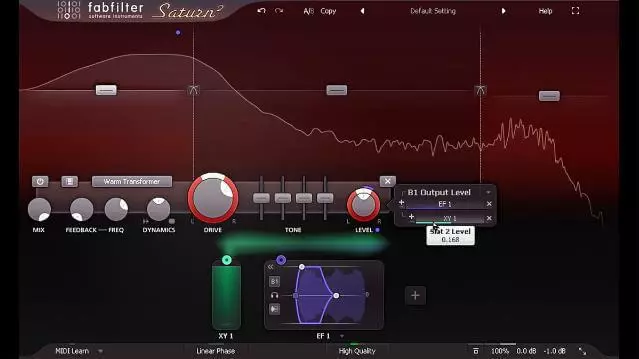
This is the most versatile and popular saturator in the world.
FabFilter Saturn 2 offers a variety of distortion and coloration options, combining multi-band processing with virtually endless modulation possibilities. From subtle, clean, and warm tube or tape saturation to the most extreme multi-band guitar amp effects, this plugin provides 12 signal distortion algorithms and plenty of other creative options.
23. Slate Digital Virtual Tape Machines
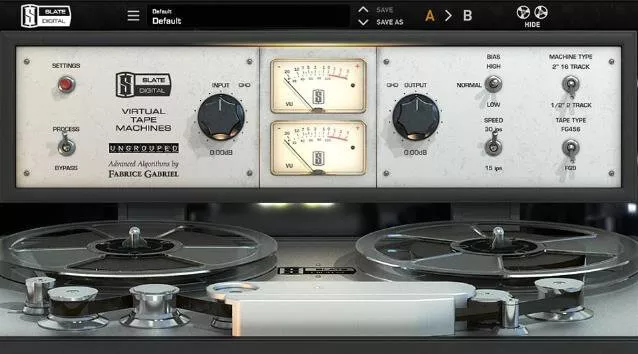
Slate Digital Virtual Tape Machines is a powerful audio plugin that emulates both a 16-track 2″ tape recorder and a 1/2″ stereo mastering deck. The plugin allows you to choose between the two most popular tape compositions.
Virtual Tape Machines accurately reproduces the behavior of tape at the two most common speeds – 15 and 30 ips. Engineers often select speed based on the material they are recording, since bass response can vary significantly. You can further adjust the bass using the equalization slider in the settings module.
24. Overloud – Gem TAPEDESK
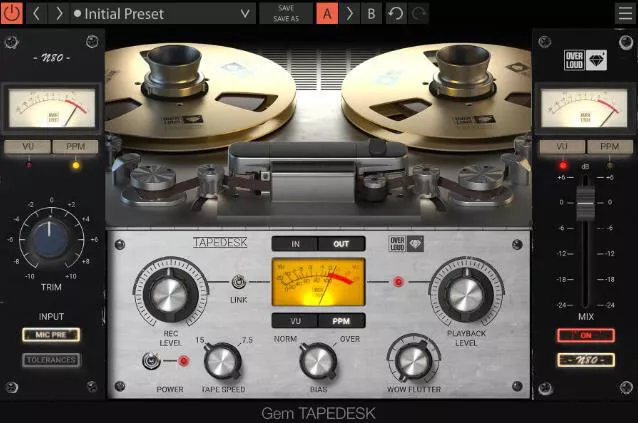
TAPEDESK is a plugin that simulates a full analog signal stream, including a professional tape recorder and console bus. The plugin’s GUI is divided into three areas: the console input channel on the left, the tape simulator in the center, and the console mixing bus on the right. The signal passes through the input channel, then through the tape drive, and ends up in the mixing channel.
TAPEDESK simulates the entire signal path to recreate the tonal characteristics of the original mixing process. In the analog world, the tape recorder is always physically connected to the console, so to reproduce the warm sound of an analog mix, you need to model both the tape recorder and the console, as well as their interaction. That’s exactly what TAPEDESK does.
You can switch between three console models: S4000, N80 and T88. They all have the same functions, but each has its own unique tone.
- The S4000 is a renowned mixing console with a clean, wide and slightly aggressive character, popular in high gain rock, metal and pop music;
- The N80 is a popular console with a rich, warm sound that adds a classic feel to your mix;
- The T88 is a sought-after console with a thick, bold tone and renowned midrange punch
25. T-RackS Tape Machine
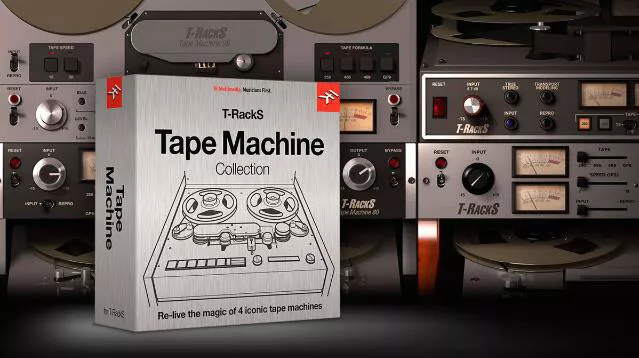
The T-RackS Tape Machine collection is the result of over two years of research and development into classic tape machines. Each device has undergone electronic and mechanical renovation.
Tape Machine 440
Introduced in the 1960s, the Ampex 440’s distinctive, all-American sound and color have made it a legend in professional mixing and mastering.
Tape Machine 80
The legendary Studer A80 Mk II, in its various versions, has become an important part of countless recordings. Manufactured in Switzerland from 1970 to 1988, this tape recorder set the standard for professional high-end multi-tracking. The A80’s unique sound walks a fine line between transparency and subtle harmonics.
Tape Machine 99
Revox PR99 Mk II, a professional stereo recorder created by Studer in the 1980s. Featuring a hybrid design that combines the best features of discrete and op-amp topologies, this model provides very smooth frequency response, especially at low frequencies, without the typical head bang. A standard for broadcast and classical music, this unit is prized by audiophiles for its exceptional sound quality.
Tape Machine 24
First produced in 1980, the MCI JH24 became a staple in American studios in the 1980s. This completely transformerless, high-performance op-amp design delivers clear, phase-consistent, and astonishingly high-quality sound that gives your music an elegant polish
26. Variety Of Sound / Bootsy FerricTDS

We have already mentioned this plugin. It is free and available to everyone. Like the other plugins described here, it does its job at the highest level, with minimal load on your computer’s processor.
27. D16 Group Redoptor

D16 Group Redoptor has received a lot of praise from EDM producers. This plugin emulates vintage saturators, giving the sound a warm, analogue feel. Also worth paying attention to are Decimort (Bit Crusher) and Devastator (Multiband Distortion) from the same company.
28. Izotope Alloy 2

iZotope develops excellent and user-friendly plugins. Even though Ozone is now in its ninth version, their Alloy 2 plugin remains popular due to its good algorithms and ease of use.
Alloy 2 includes all the basic and necessary modules for processing: EQ, Transient Shaper, Exciter, Dynamics 1, Dynamics 2, De-esser and Limiter.
29. 112dB Redline Preamp

Opinions about the 112dB Redline Preamp plugin and its manufacturer are divided. Some engineers claim they haven’t heard a more transparent sound, while others are simply unfamiliar with the line. Redline Preamp saturates the sound with harmonics, making it thicker and more “alive”.
30. ToneBoosters Ferox

Another great saturator from ToneBoosters that is available at a reasonable price and is popular among renowned mixing engineers. Unfortunately, there are no more updates for it and algorithm support has probably ended, but even today this VST exciter delivers great sound!
In the presets you can find interesting presets for quickly saturating the audio signal.


